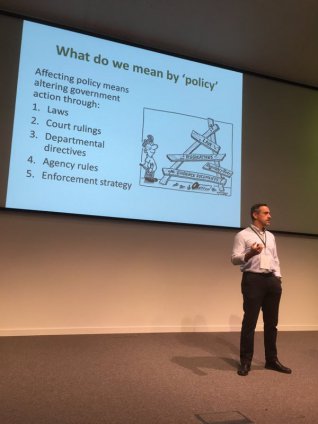Maximising the policy impact of your scientific research
At the recent joint BES and CCI Symposium ‘Making a Difference in Conservation: Improving the Links Between Ecological Research, Policy and Practice’ Journal of Applied Ecology Executive Editor, Marc Cadotte, and Associate Editor and Policy Direction author, Sarah Durant coordinated a workshop on maximising the policy impact of scientific research. This post was first published on the Applied Ecologist’s Blog.

In recent years there has been an evolution of the types of papers journals publish and as funders increasingly require impact it is becoming increasingly important to provide the policy and applied recommendations that can be taken from your research.
The workshop was split into two sections, with Marc discussing how to achieve and communicate policy relevant research and Sarah focusing on how to maximise policy impact when working overseas. The primary concerns of workshop attendees, who ranged from academics to practitioners to those who work somewhere in between, included:
- access to the funding and resources to engage with policy when publication often comes at the end of the grant period
- access to the scientific evidence in the form of papers is a huge barrier for practitioners, but not all academics can pay for open access
- practitioners rarely read primary scientific papers and need information distilled into accessible and policy/management relevant formats
- the novelty and generality required by many journals doesn’t necessarily fit with engaging with policy, which often requires details on a specific situation
- the door to engage with politicians isn’t always open – how can this be overcome?
- influencing policy seems to depend on knowing people who define policies.
In this blog post I have listed the key take-home messages from the workshop for maximising the policy impact of your scientific research. It was agreed that as a scientist you should bear some of the responsibility to communicate the policy implications of your research – you are best placed to communicate your research because you have unique insights into the topic, you can best represent your research and you may be funded by public money.
#BEScci @urban_sci Scientists should bear some responsibility to communicate policy implications of their research e.g. through blogs, media
— JAppliedEcology (@JAppliedEcology) April 12, 2016
There are many reasons why ecologists should prioritize policy communication and you can also read Marc’s post on who should communicate the policy implications of ecological research here.
Tips for maximising the policy implications of your research:
- Bear in mind that policy instruments are complex. Where you lack experience in this complexity seek advice from an expert who specialises in the aspects of policy your research could affect.
- Distil evidence into accessible and policy-relevant formats e.g. lay summaries, policy briefs, short reviews (the IIED briefings are good examples of this).
- Choose the right journal to increase the chances that the relevant policymakers will see the paper when it is published.
- Plan ahead and make the policy relevance of your article clear, especially in the abstract. You can read Marc’s tips on planning and execution, writing clearly and effectively and post publication communication in the presentation slides.
Applied ecology should be planned wt direct policy/management relevance; talk to managers/politicians Marc Cadotte #BEScci @JAppliedEcology
— Catherine Duigan (@kate_llyn) April 12, 2016
- Engage policymakers right from the start, and – although it may sound obvious – know your problem. What aspects of policy may need to change? What are the policy implications of your evidence? What is the scale of the effect – Local/ National/ Regional/ International?
- Think about what the potentially relevant policy instruments are e.g. relevant national legislation or international policies such as CBD, CITES, CMS, and which are likely to have the strongest impact and are most practical for what you want to achieve.
- Think about whether you will need funding to consider the policy aspects of your research in your original proposal. Sometimes this can be difficult as you don’t always know what the policy implications will be until you have your results, but it is often possible to hazard a good guess. Very often the add-on does not mean significant additional funding and separate policy funding streams are available.
- Bring the scientific community together so that there is a majority scientific consensus on the evidence e.g. the new Policy Direction format provides a good forum for doing this – see, for example, Developing fencing policies for dryland ecosystems. This makes it much easier for practitioners to understand and make use of your evidence.
- Be aware of different perspectives and build relationships of trust with governments (this may be especially important for conservationists trying to increase policy impact in overseas research).
How can conservationists increase policy impact in overseas research? By @SarahMDurant at #BEScci pic.twitter.com/Frfl7HQFYa
— Niki Rust (@NikiRust) April 12, 2016
- Use social media to communicate and share knowledge.
- After publication communicate your research through blogs and local and national media. As discussed later in the CCI-BES Symposium meeting by Serah Munguti from Nature Kenya and Fiona Fox from the Social Media Centre it is important that scientific stories make it into the media because the public pay attention to the media and policymakers take into account what the electorate are saying when making decisions.
The final, and possibly the most important take-home message from the workshop was to talk to people about the policy implications of your research. Communication is crucial. You know your evidence better than anyone else and if you don’t engage – then who will?
Like what we stand for?
Support our mission and help develop the next generation of ecologists by donating to the British Ecological Society.